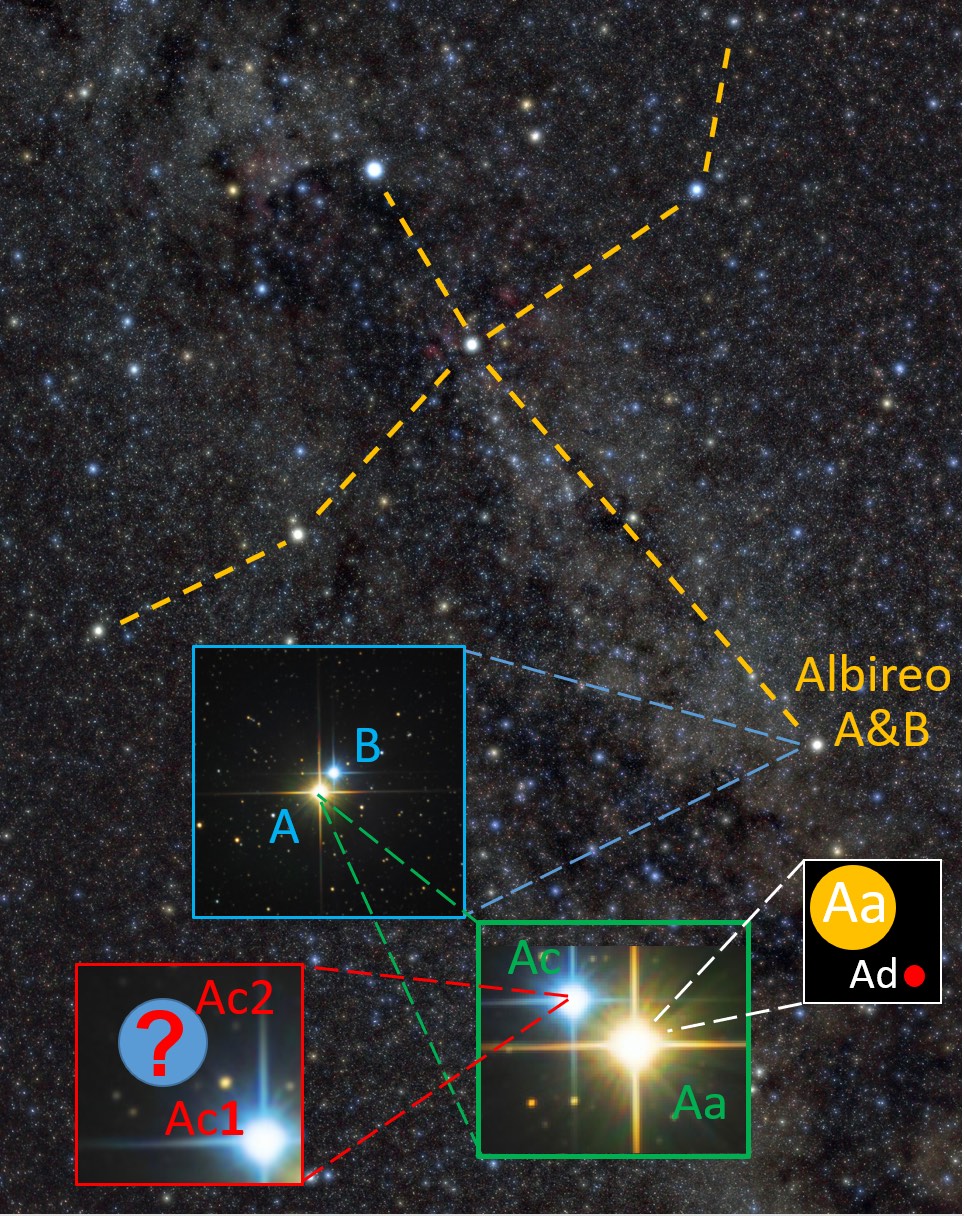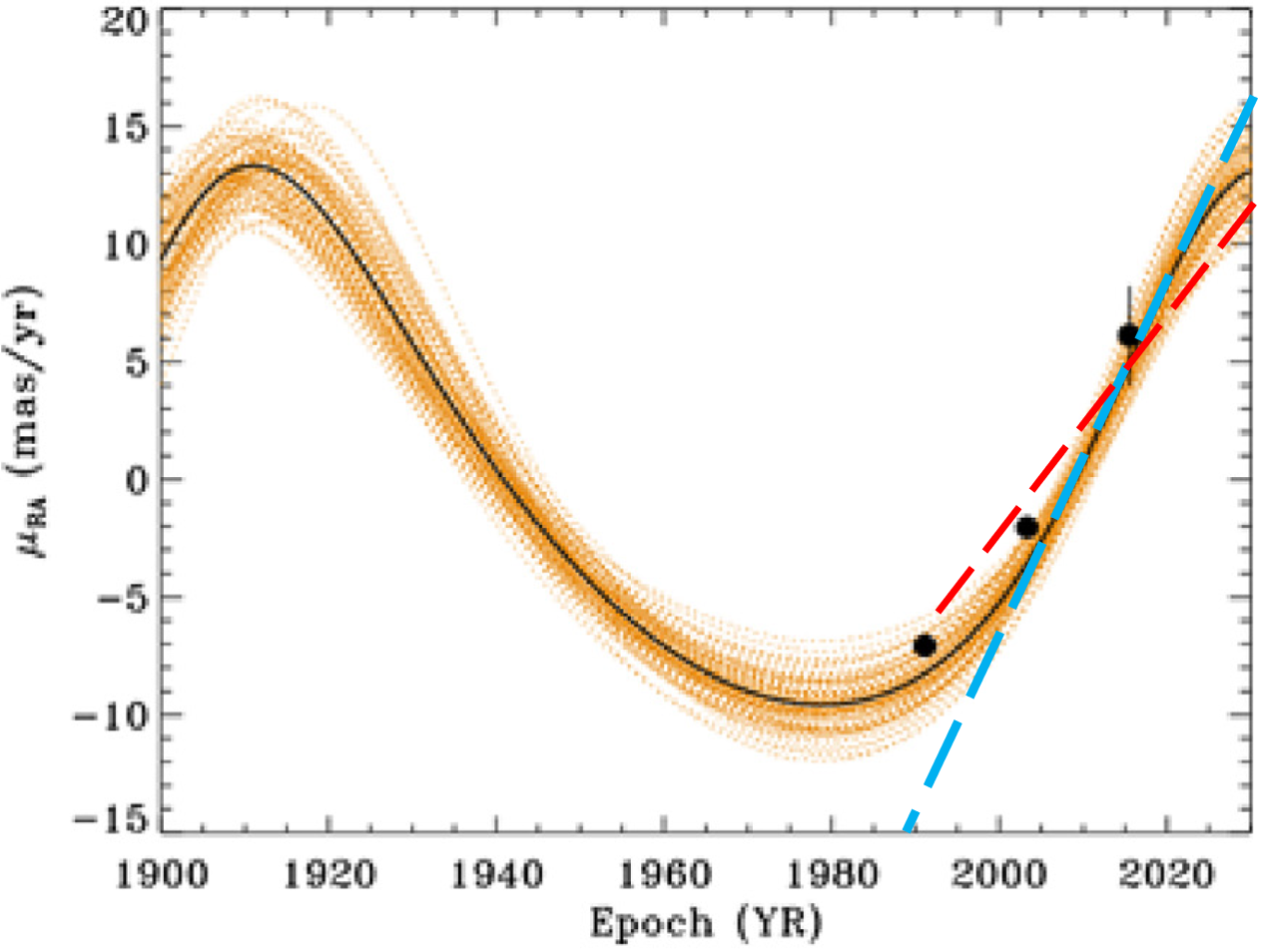IoW_20230209 - Gaia
Image of the Week
Missing mass in Albireo Ac: massive star or black hole?
Figure 1. The star Albireo, also known as beta Cygni, is perhaps the most popular two-coloured double star in the whole sky. To the naked eye, it is just one star. In a pair of binoculars it resolves into a beautiful pair of orange and blue. At closer scientific scrutiny it further divides into several components – with one of them being a bit of a riddle (red box). The image shows a photo of star clouds in the northern summer Milky Way, covering the well-known constellation Cygnus, the flying swan (orange dashed lines). It includes the star Albireo (below center at right) and sketches its decomposition into several physical parts (coloured boxes). Credits: Milky Way background image: Uwe Reichert, Schwetzingen, Germany. Close-up Albireo A/B photo: Johannes Schedler, Graz, Austria.
For about 400 years, roughly since the invention of the telescope in the early 17th century, the bright star Albireo has been known to be a beautiful double. Twentieth-century astrophysics characterized the brighter orange partner (“Albireo A”) as a cool giant star of about five to six solar masses, and the fainter blue one (“Albireo B”) as a hot star of order three to four solar masses.
Already about a hundred years ago, radial-velocity measurements made it clear that the giant Albireo A itself must be a close double. But it took till 1976 to image and measure its very close companion. Thus the giant got renamed Albireo Aa, while the partner got the designation Albireo Ac. Later that partner was characterized as another hot star, a bit less hot and a factor 3 less luminous than long-known Albireo B.
Albireo Ac is too close to Aa to be seen in ordinary telescopic view, even in big instruments. A special technique called speckle interferometry was needed to find it, and to subsequently measure its orbital motion around Aa. By the year 2020, the orbit had been measured sufficiently well to settle its size, shape and period – about 120 years. All observational data – radial velocities, relative motion of the partners Aa and Ac on the sky, their brightness and colours, as well as the distance from the system’s parallax – agreed well within their uncertainties.
Enter the absolute motion of the giant Aa on the sky, as measured by Hipparcos and Gaia, and the neat picture gets completely destroyed. The discrepancy was first noticed in 2018, from just the values of Aa’s proper motions around 1991, 2003 and 2015. They differ much too strongly, but strangely they do so in rough agreement with the established speckle interferometry orbit. In other words: Albireo Ac gravitationally accelerates its bright partner Aa by an exorbitant degree. Either the giant star Aa is very much lighter than reasonably estimated by astrophysicists, or else the partner Ac is much heavier than derived by similar logic.
The former suggestion – Aa being too light – was firmly dismissed in 2019 already, by a careful spectroscopic study of the giant. Just about one year later, a deep analysis of the system - using all available data from radial velocities to speckle interferometry and absolute astrometry - confirmed that the close partner Ac is way too heavy: between 5 and 7 solar masses instead of its astrophysical estimate of somewhat below 3 solar masses.
This riddle is caused by four astrometric quantities: The proper motions from the Hipparcos Catalogue and from Gaia Data Release 2, plus the two positions measured by these two same missions. Either of these four might in principle be corrupted by the unresolved multiplicity of Albireo A. But they would have to be disturbed by an unreasonably large amount to explain the mystery. Also, the Aa proper motion in Gaia’s Data Release 3 fully confirmed - and even strengthened – the finding. Ac still seems much too heavy; very little doubt is left. Nevertheless, an entirely independent astrometric confirmation of the much-too-large acceleration of Albireo Aa would be highly desirable.
That confirmation is available now. It was found in the course of the scientific validation of preliminary double-star solutions using the extended mission time interval to go into Gaia’s Data Release 4 (DR4) in about two years. For the first time, it was possible to firmly measure the acceleration of Aa directly – rather than inferring it from the change of proper motion over an extended time interval. The resulting value grossly disagrees with the assumption of Ac having the astrophysically motivated 2.7 solar masses, and it nicely agrees with the otherwise derived 5-7 solar masses. For the acceleration in east-west direction, this is illustrated in Figure 2, below. This result could not have been achieved using Gaia DR3 data, but it is now possible – by combining the improved data processing we are developing for Gaia DR4 with the extensive additional knowledge that is available in the special case of Albireo.
Figure 2: The east-west motion of Albireo Aa as function of time, in units of milli-arcseconds per year. The black dots signify the three astrometric motion measurements mentioned in the text. The black curve is the prediction of that motion from the 2020 combined analysis of the Albireo system which had given the hitherto strongest evidence for the much-too-heavy Albireo Ac. The blue dashed line represents Gaia’s new independent measurement of Aa’s acceleration around the year 2015. It agrees well with the slope of the black curve around 2015, i.e. with the prediction for a high mass of Ac. In contrast, the red line represents the expected acceleration of Aa from the astrophysically expected 3 solar masses for Ac. It clearly deviates from the slope of the black curve. The orange curves indicate possible variants of the black curve which are still compatible with all observational data. Credits: R. Drimmel et al., MNRAS 502, 328–350, 2021
Astronomers invariably get excited whenever invisible masses of more than twice the solar mass turn up. They could be black holes. Thus, excitement was high when in November 2022 an international team of astronomers announced the definitive discovery of a black hole from an astrometric binary orbit in Gaia’s Data Release 3 – when combined with other measurements that the team itself had taken. This find was called Gaia BH1 (“Black Hole 1”). It is the closest known black hole ever, being only about 480 Parsec (or 1600 lightyears) from the Sun.
Could the unseen mass in Albireo Ac be another “Gaia Black Hole”? It clearly could be. It would have to be in a very close orbit around the visible star Albireo Ac. If so, it would be the new record holder of most-nearby black hole, as Albireo is only about 100 Parsec (300 lightyears) from the sun. Difficult investigations with a variety of methods and instruments will be needed to definitely prove that. These surely will be undertaken, because the question is really exciting. But, as a caveat, it should be mentioned that there is a second possibility: Albireo Ac could – once again! – be a pair of two stars. These would have to be two very similar hot stars, both just slightly less massive and both just half as luminous as the presently assumed single star Ac. This possibility does not fit the available data well, but it is just barely compatible with them. Again, difficult follow-up work will be needed to confirm or disprove this second variant.
As a funny side remark, it is noted that still another member of the Albireo system has been found last year by a Mexican/German group of astronomers: Albireo Ad is a faint red dwarf star circling the orange giant Aa in a tight orbit every 371 days. However, with its mass of only 0.1 solar, this little guy has absolutely nothing to do with the Aa/Ac mass riddle. And just for historic interest it may also be worthwhile to mention the non-existing system member Albireo Ab: Some decades ago, there was a claim from speckle interferometry data that there is another component. It was named Ab, but it was never seen again. Even if it should exist, it again – like Ad - would have no relevance for mysterious Ac and its mass.
Further reading
U. Bastian and R. Anton, The mass of Albireo Aa and the nature of Albireo AB: New aspects from Gaia DR2, Astron. Astrophys. 620L, 2B, 2018
D. Jack et al., Stellar Parameters of Albireo Aa determined with high-resolution spectroscopy, RNAAS 3, 33, 2019
R. Drimmel et al., A celestial matryoshka: dynamical and spectroscopic analysis of the Albireo system, MNRAS 502, 328–350, 2021
D. Jack et al., Yet another star in the Albireo system: The discovery of Albireo Ad, Astron. Astrophys. 661A, 49J, 2022
Credits: Story written by Ulrich Bastian on behalf of DPAC’s CU3/astrometry and CU4/non-single stars data reduction teams.
[Published: 09/02/2023]
- Removed a total of (7) style text-align:center;
- Removed a total of (15) style text-align:justify;
Image of the Week Archive
- Removed a total of (1) border attribute.
- Removed a total of (1) cellpadding attribute.
- Removed a total of (1) cellspacing attribute.








































 Sign in
Sign in
 Science & Technology
Science & Technology

